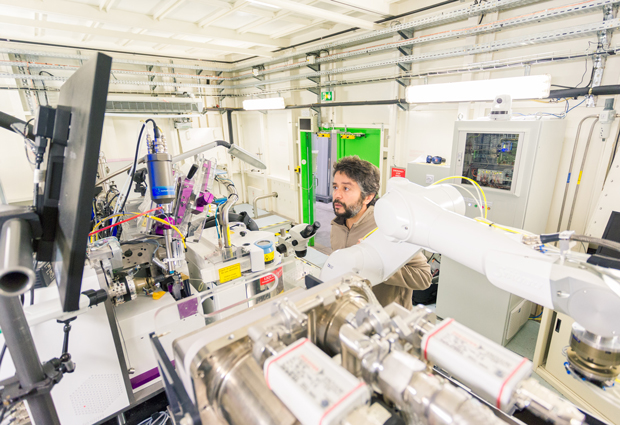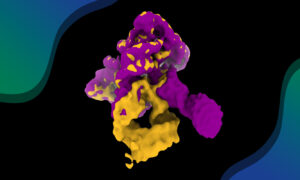
Beamline 14’s legacy
Beamline BM14 in Grenoble shuts down, continues collaboration with India

“Take your time,” Hassan Belrhali tells me as I rush to finish my lunch. It’s 2 pm in EMBL’s Grenoble site canteen and most people have already left to get back to work. The soft-spoken scientist sits across from me, patiently. But when we start to talk about his work with Beamline 14, his voice quickens. In excited tones Belrhali shares stories of the beamline and the science it helped make possible at the European Synchrotron Radiation Facility (ESRF).
Between 2010 and 2016, a fruitful collaboration between EMBL, the ESRF and the Regional Centre for Biotechnology (RCB) based in New Delhi, India allowed hundreds of Indian scientists to access the resources and services offered by EMBL and ESRF and to further their research at a pace that wouldn’t have been possible otherwise. But, like other beamlines at the ESRF, BM14’s time is drawing to a close. My lunch finally eaten, I follow Belrhali to the synchrotron to learn more about the legacy of both the instrument and the collaboration it supported.
The beginning of an adventure
A pair of bright green double doors signals the entrance to Belrhali’s office, which is decorated with both the EU and Indian flags and a sign that reads, ‘Welcome to BM14, an ESRF-EMBL-India MX MAD Beamline.’

MX is short for ‘macromolecular crystallography,’ the study of determining the 3D structure of large molecules. MAD, on another hand, stands for ‘multiple anomalous dispersion,’ a technique that lets scientists determine 3D structural details of a molecule by comparing its diffraction patterns at different wavelengths. In 2006, Belrhali and Amit Sharma, from the International Centre for Genetic Engineering and Biotechnology in India, used a similar technique at BM14 to elucidate the structure of a molecule that lets a malaria parasite enter and infect human red blood cells.
The results of their study were instrumental in further understanding malaria. In an effort to let others benefit from the same resources they had had access to, Belrhali and Sharma decided to create a formal partnership with ESRF and EMBL. Their idea was to allow the whole Indian scientific community to access the powerful tools from BM14 and take their experiments to the next level.
Most Indian users run experiments on a ‘home source,’ which uses the same principles as X-ray machines in hospitals: an electron beam fires at a piece of metal, exciting the atoms which then emit X-rays as they relax down to their ‘ground state.’ Just as Belrhali and Sharma had found during their work on malaria, biological crystals often diffract poorly at in-house sources. Determining 3D structures became very challenging. As more users grew frustrated with their resources, Belrhali tells me, “the natural evolution was that they gained access to BM14.”
Into the synchrotron
From the outside, the ESRF facility is so big that it is easy to forget that it is ring-shaped. On the inside it is even more impressive: Belrhali and I stand above the large outer ring of the synchrotron and a labyrinthine corridor of 43 beamlines radiating off of the main ring. Below our feet, the electron beam hurtles through the 850-metre circumference at nearly the speed of light, just like it does 24 hours a day. Behind us, a scientist idly whizzes past us on a scooter.
The ESRF creates X-rays by accelerating electrons around the huge ring layered with magnets. The magnets control the speed and direction of the electrons; whenever they accelerate electrons around the ring they also generate X-rays that are fired off tangentially. At each of those points a beamline channels those X-rays and uses them for a particular experiment.

EMBL and ESRF manage seven beamlines together and make them available to around 2500 structural biology users each year. Every day they enable the elucidation of new structures for biological macromolecules, but also technical advancements to make crystallography experiments more efficient.
Slowing down
Some scientists joke that when you’ve seen one beamline, you’ve seen them all. At a glance, they look alike. But in fact, each beamline runs different experiments, is run by a different scientist and specialises in different techniques. BM14, or Bending Magnet 14, is a dedicated crystallography beamline for macromolecules; it is run in collaboration by the RCB, ESRF and EMBL and was one of the first beamlines to use the MAD technique on biological material. It is also one of the last beamlines where things are still run by hand.
It’s the end of an era. But the collaboration is not over yet
“BM14 is like one old taxi with lots of charm. An experiment is like the landscape – with BM14, you have time to immerse yourself in it,” Belrhali says. “New beamlines are like new taxis – fast and shiny. But in the end, both can get you to your destination.” Technological improvements in beamline technology have allowed experiments to run autonomously, remotely and with better resolution. It is these beamlines that are in higher demand, and BM14 is in the process of being shut down to make way for them.
The impact of BM14 on Indian research and the development of structural biology in India is considerable. Between 2010 and 2016, 58 groups from 34 institutes visited BM14. Here, hundreds of experiments took place and 418 papers were published. Belrhali is considering a second career as a teacher, in order to continue sharing his passion with students and spreading the best practices on the most advanced technologies. “BM14 was a fantastic place to train new students and enable experiments that were near impossible in India,” he exclaims. “It’s the end of an era. But the collaboration is not over yet.”
Building upon the very fruitful collaborative relationship that BM14 enabled, EMBL and India are looking to identify and encourage new, long-term cooperative activities of mutual benefit in fields of common interest.


